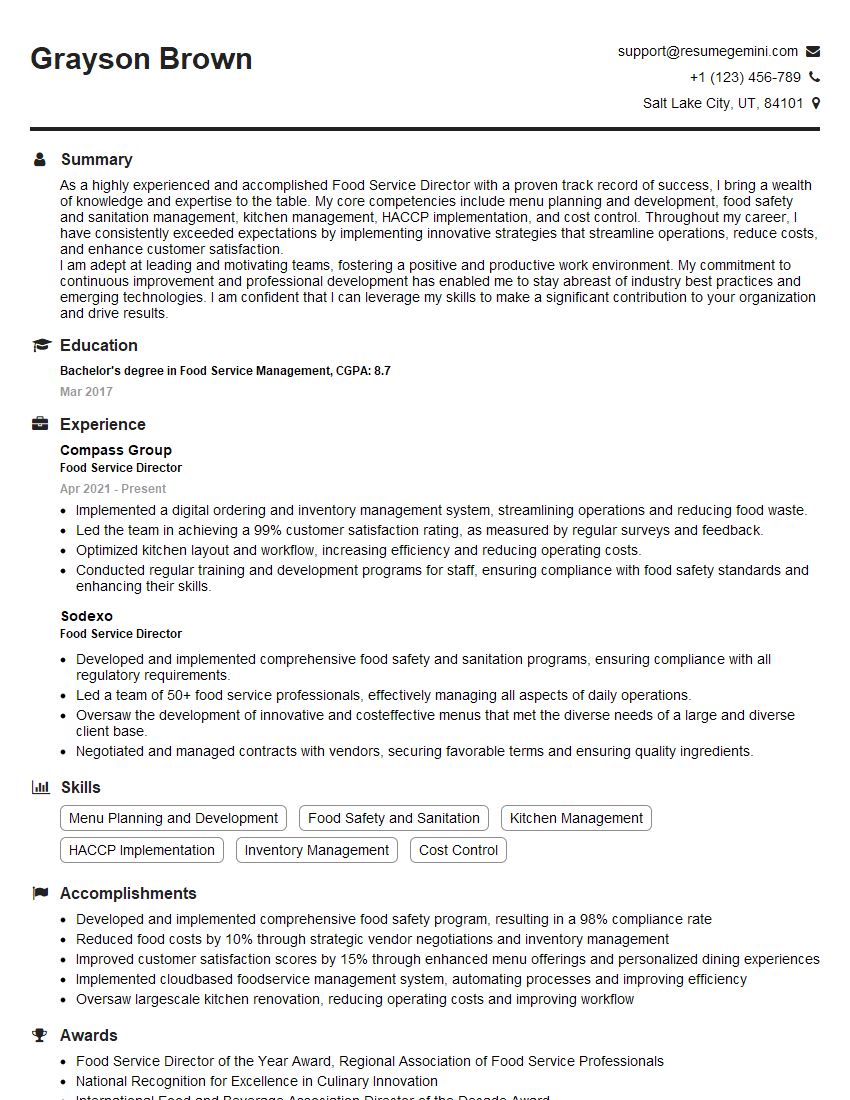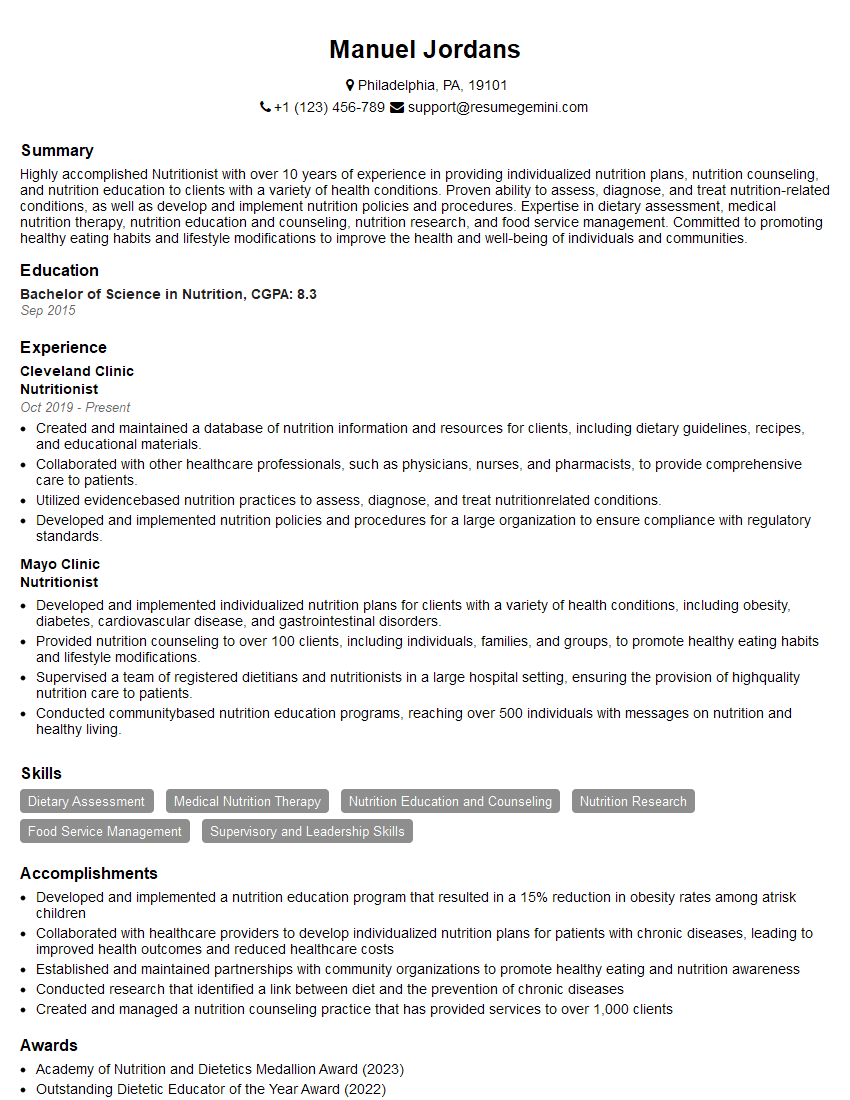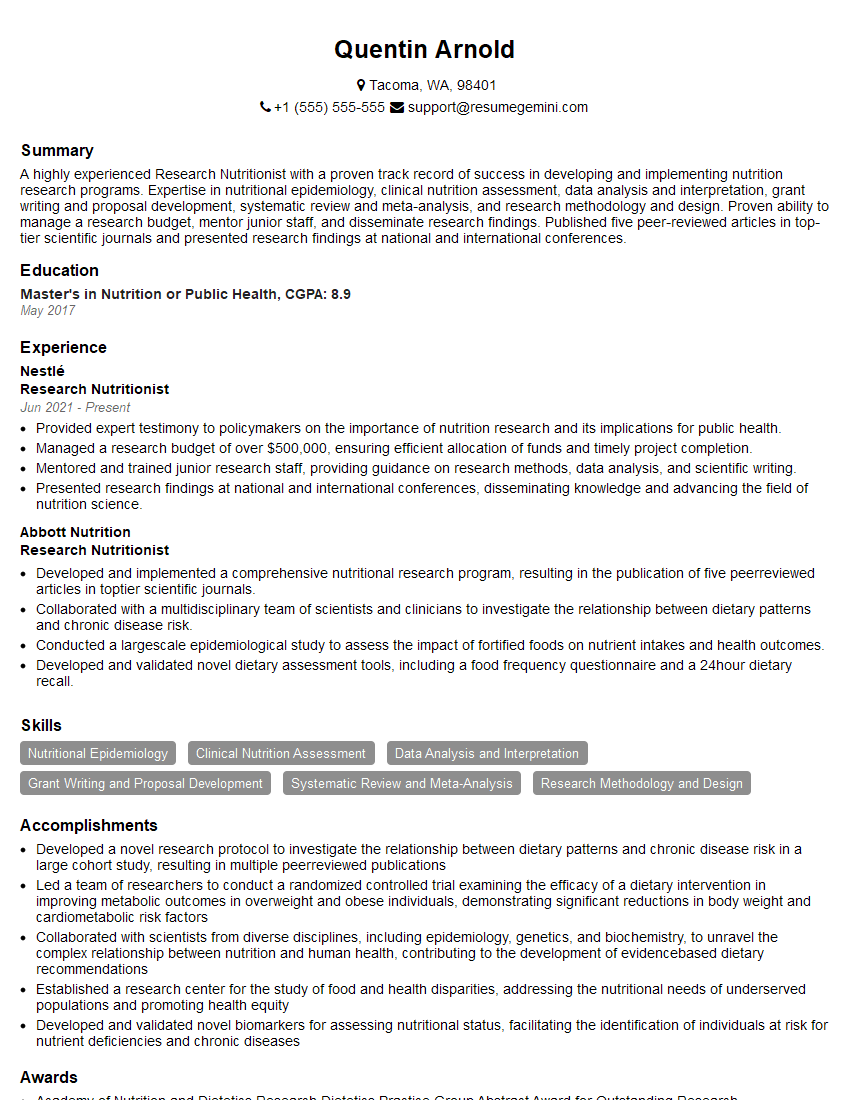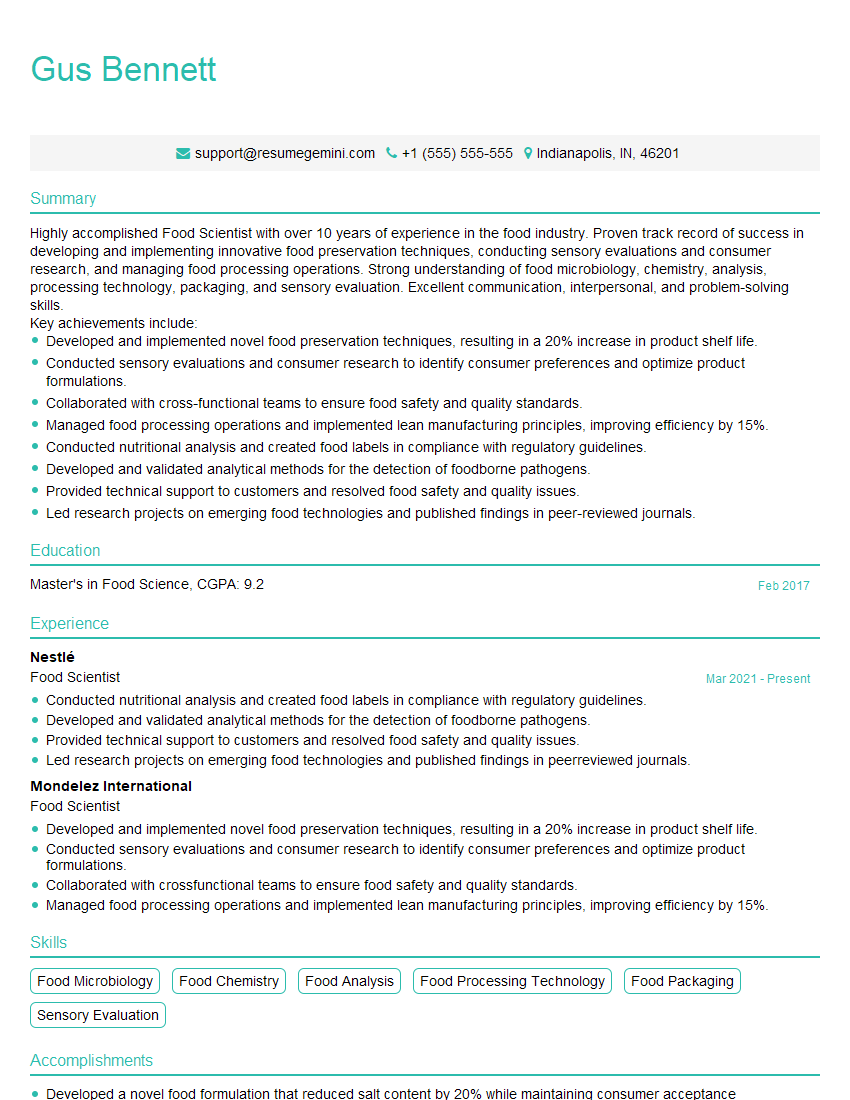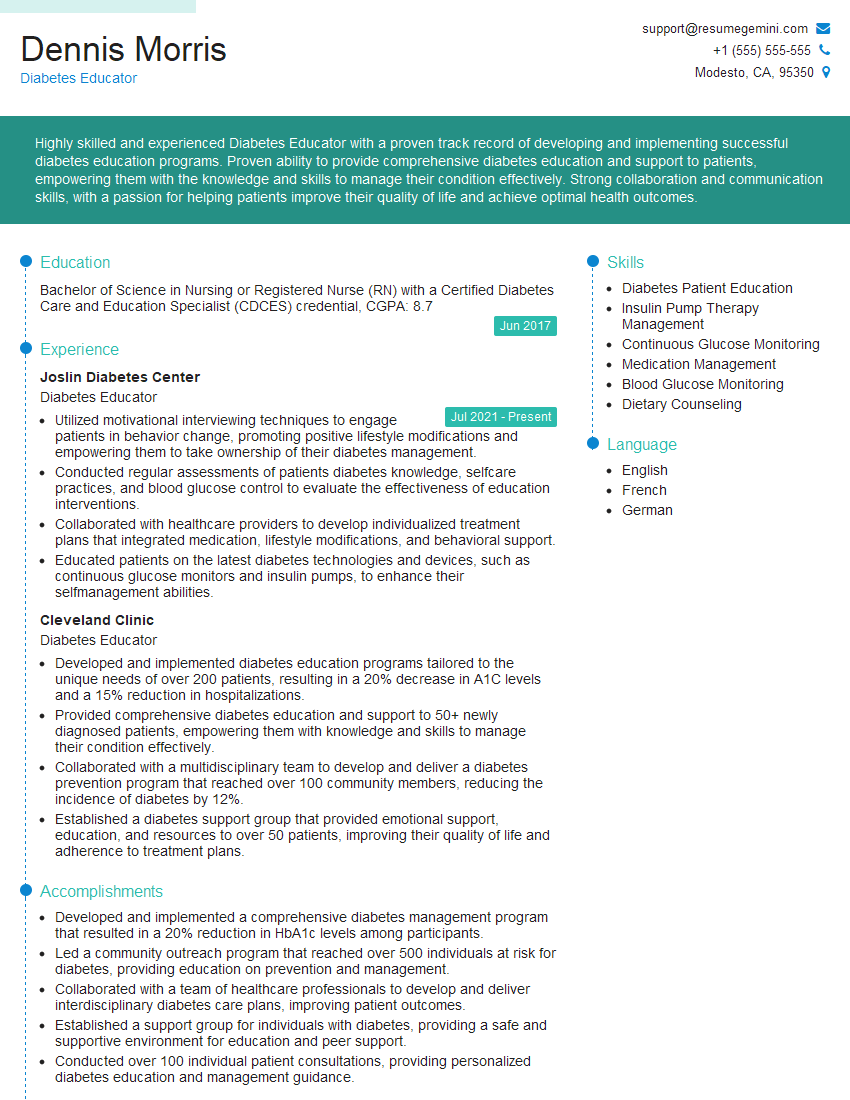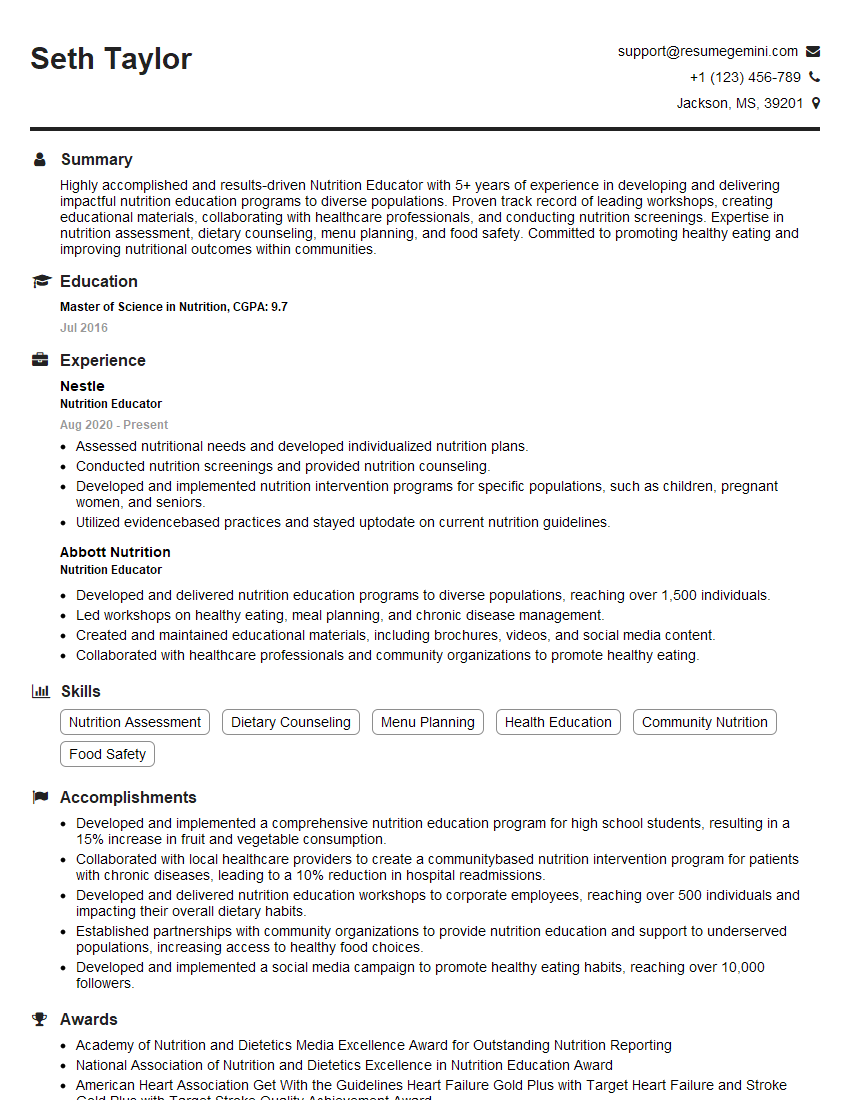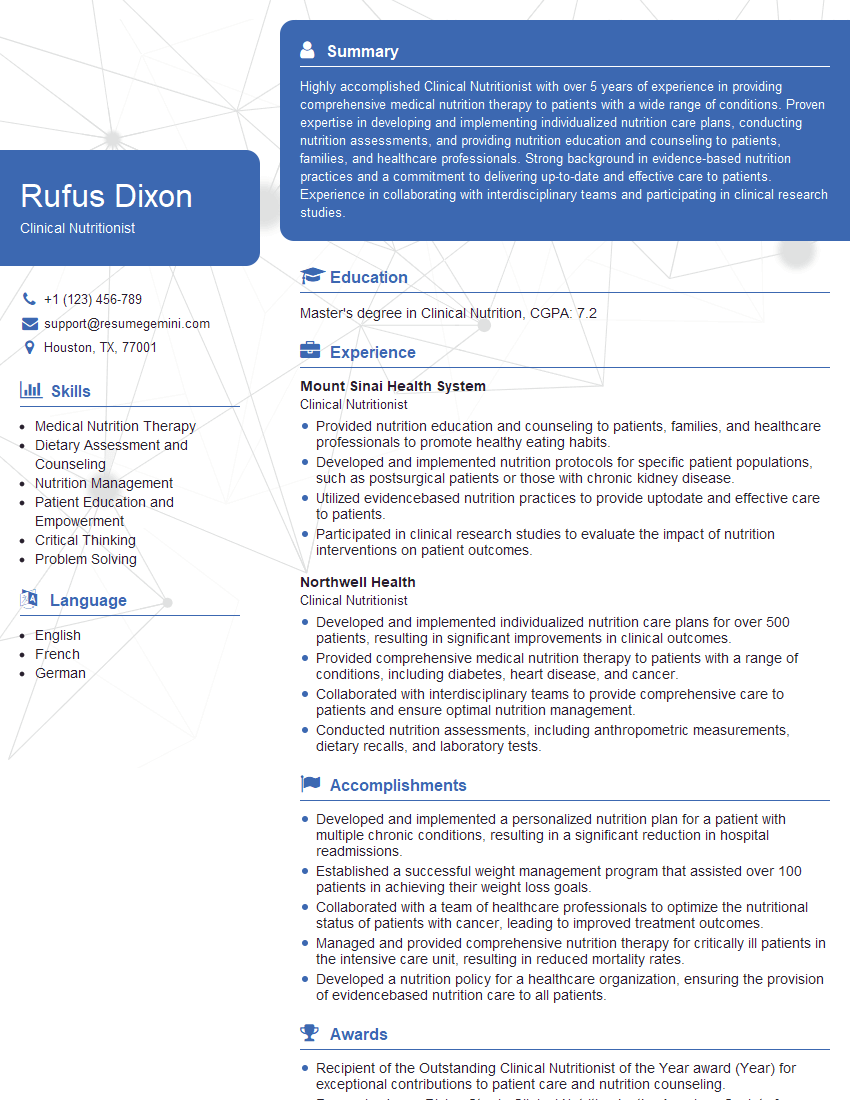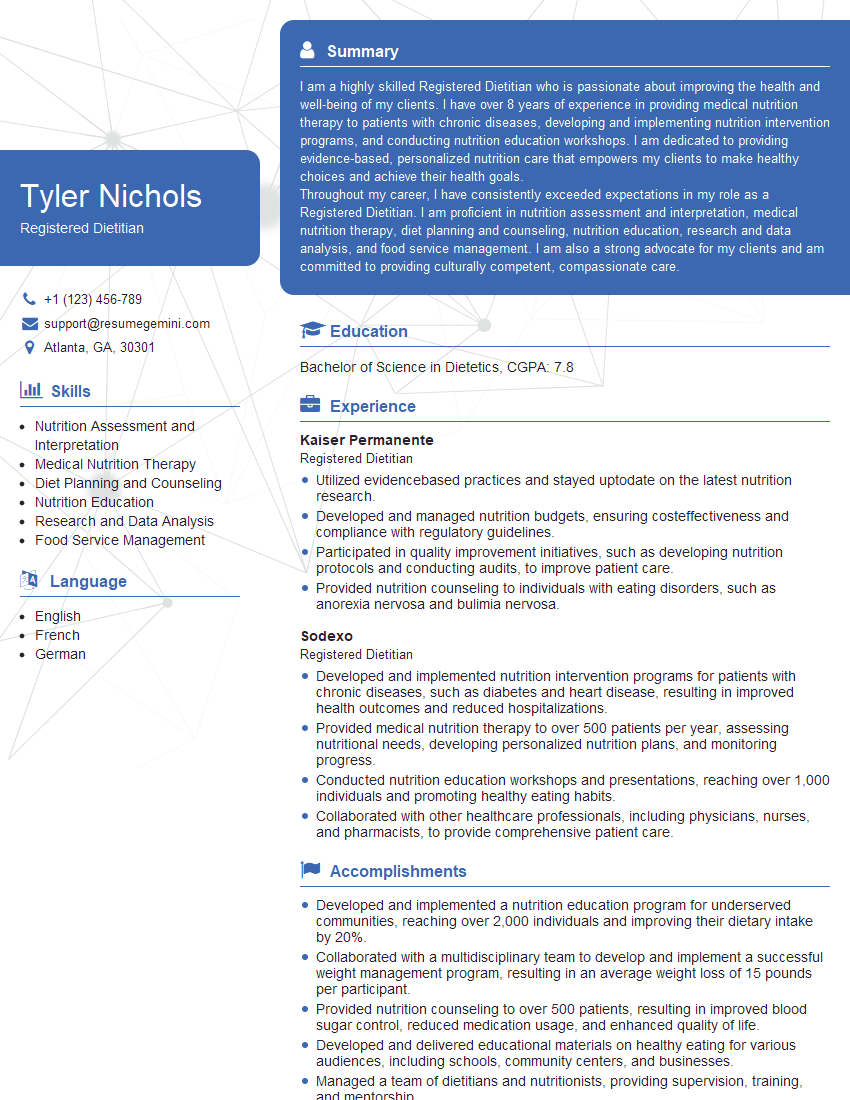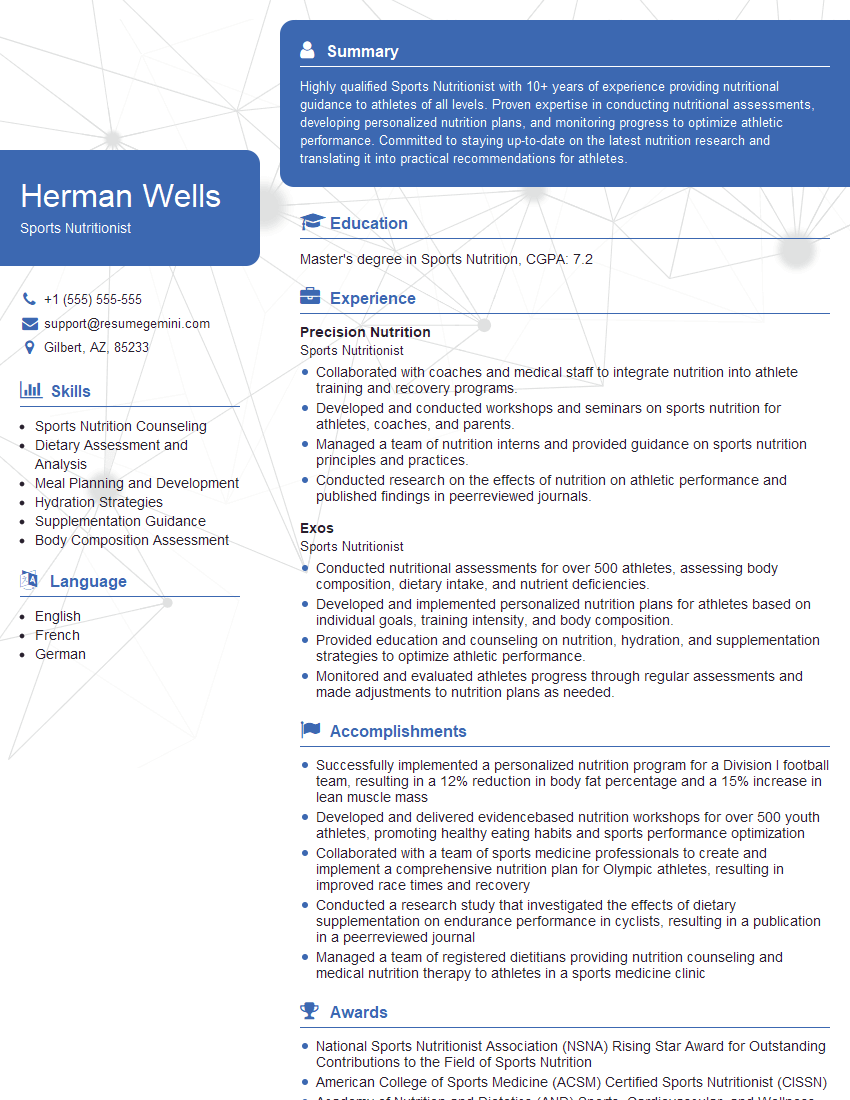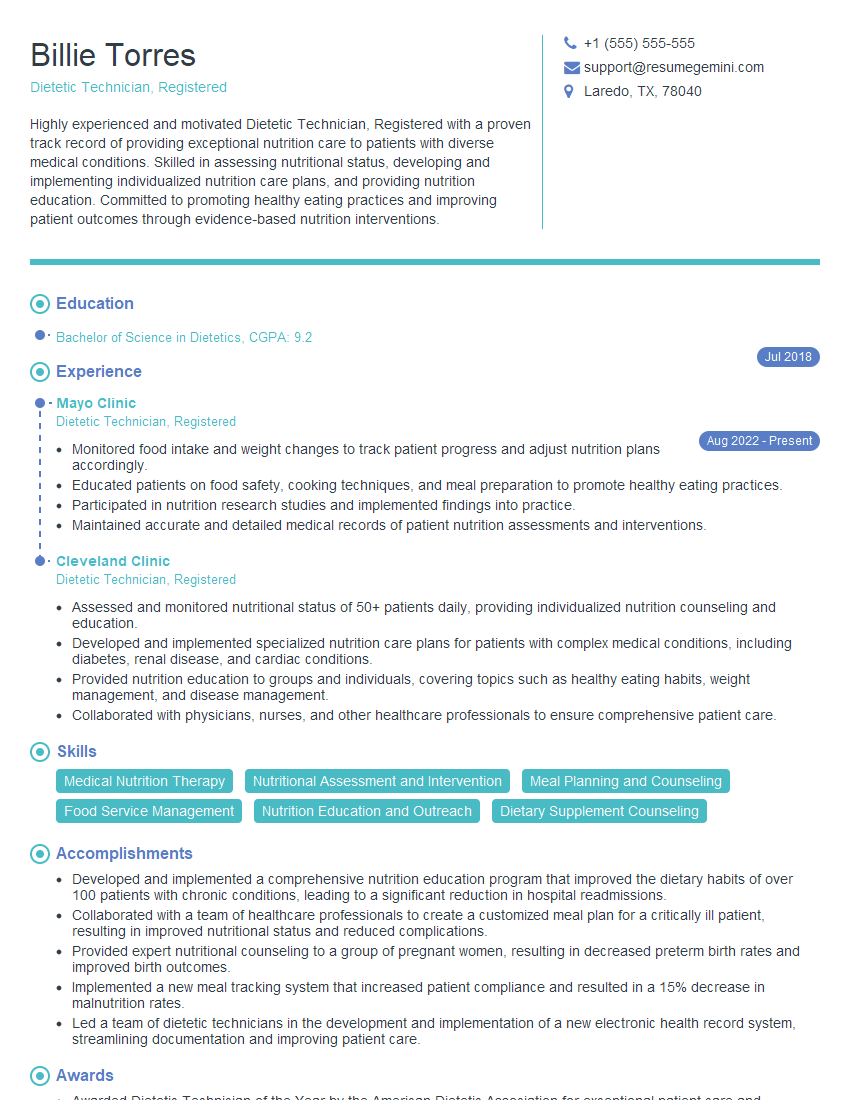Cracking a skill-specific interview, like one for Knowledge of Nutrition Science, requires understanding the nuances of the role. In this blog, we present the questions you’re most likely to encounter, along with insights into how to answer them effectively. Let’s ensure you’re ready to make a strong impression.
Questions Asked in Knowledge of Nutrition Science Interview
Q 1. Explain the difference between macronutrients and micronutrients.
Macronutrients and micronutrients are both essential components of a balanced diet, but they differ significantly in the quantities needed and their roles in the body. Macronutrients are the energy-yielding nutrients that we need in relatively large amounts: carbohydrates, proteins, and fats. They provide calories, the fuel that powers our bodies. Micronutrients, on the other hand, are vitamins and minerals, needed in smaller quantities, but are vital for various metabolic processes. Think of it like this: macronutrients are the bricks that build your house (providing energy and structure), while micronutrients are the mortar that holds them together (facilitating bodily functions).
Q 2. Describe the role of carbohydrates, proteins, and fats in the body.
Carbohydrates, proteins, and fats each play distinct, crucial roles:
- Carbohydrates: The body’s primary source of energy. They’re broken down into glucose, which fuels our cells. Think of glucose as the gasoline for our cellular engines. Examples include grains, fruits, and vegetables.
- Proteins: Essential for building and repairing tissues, making enzymes and hormones, and supporting immune function. They’re composed of amino acids, the building blocks of life. Think of proteins as the construction workers of the body. Examples include lean meats, fish, beans, and lentils.
- Fats: Provide energy, insulate our bodies, protect organs, and help absorb certain vitamins. They also contribute to cell membrane structure and hormone production. Healthy fats are crucial for optimal brain function. Examples include avocados, nuts, seeds, and olive oil.
A balanced diet incorporates all three macronutrients in appropriate proportions for optimal health.
Q 3. What are the recommended daily allowances (RDAs) for essential vitamins and minerals?
Recommended Daily Allowances (RDAs) for vitamins and minerals vary based on age, sex, and other factors. There’s no single universal RDA. It’s best to consult the Dietary Reference Intakes (DRIs) published by the National Academies of Sciences, Engineering, and Medicine. These reports provide detailed information. However, I can offer a general idea: Vitamin D, Calcium, and Iron are commonly deficient, and their RDAs depend significantly on age and gender. For example, adult women often require more iron than men. It’s crucial to understand that exceeding the recommended intake of some vitamins and minerals can be harmful. A healthcare professional or registered dietitian can help determine individual needs based on a comprehensive assessment.
Q 4. Explain the concept of the glycemic index and its importance in nutrition planning.
The glycemic index (GI) ranks carbohydrate-containing foods based on how quickly they raise blood glucose levels after eating. Foods with a high GI cause a rapid spike in blood sugar, while low-GI foods cause a slower, more gradual rise. This is important for managing blood sugar levels, especially for individuals with diabetes or those trying to lose weight. For instance, a sugary drink (high GI) will lead to a quick rise and fall in blood sugar, prompting insulin release and potentially fat storage, whereas whole grain bread (low GI) will provide sustained energy.
In nutrition planning, considering the GI helps to create meal plans that minimize blood sugar fluctuations, promoting stable energy levels and preventing energy crashes. Combining high-GI foods with proteins and fats can help moderate the glycemic response.
Q 5. How do you assess a patient’s nutritional status?
Assessing a patient’s nutritional status involves a multi-faceted approach, combining several methods:
- Anthropometric measurements: This includes height, weight, body mass index (BMI), waist circumference, and skinfold thickness to assess body composition.
- Biochemical tests: Blood and urine tests evaluate levels of vitamins, minerals, proteins, and other substances to detect deficiencies or imbalances.
- Clinical examination: A physical examination can reveal signs of malnutrition, such as muscle wasting, edema, or skin lesions.
- Dietary assessment: This involves gathering information about the patient’s usual food intake through methods like 24-hour dietary recalls, food frequency questionnaires, or food records.
- Patient history: Understanding medical history, lifestyle, socioeconomic factors, and medication use provides crucial context for interpreting other assessment data.
The combination of these methods provides a comprehensive picture of the patient’s nutritional status.
Q 6. What are the common signs and symptoms of malnutrition?
Signs and symptoms of malnutrition are diverse and depend on the specific nutrient deficiencies and the severity of the condition. Common indicators include:
- Weight loss or gain: Significant changes in weight can signal nutritional problems.
- Fatigue and weakness: Lack of energy is a common symptom of various nutritional deficiencies.
- Muscle wasting: Loss of muscle mass is a visible sign of protein deficiency.
- Skin changes: Dry skin, poor wound healing, and skin lesions can indicate deficiencies in vitamins and minerals.
- Hair loss: Hair loss can be a sign of protein or nutrient deficiencies.
- Swollen limbs (edema): Edema can be caused by protein deficiency.
- Impaired immunity: Nutrient deficiencies weaken the immune system, leading to increased susceptibility to infections.
These are just a few examples, and the specific symptoms will vary.
Q 7. Describe different dietary approaches (e.g., ketogenic, Mediterranean, DASH).
Several dietary approaches cater to various health goals and preferences:
- Ketogenic diet: This diet is very low in carbohydrates and high in fats, forcing the body to burn fats for energy (ketosis). It’s sometimes used for weight loss and epilepsy management but requires careful planning and monitoring.
- Mediterranean diet: This diet emphasizes fruits, vegetables, whole grains, legumes, nuts, seeds, and olive oil, with moderate consumption of fish and poultry and limited red meat. It’s associated with reduced risk of heart disease and other chronic conditions.
- DASH (Dietary Approaches to Stop Hypertension) diet: This diet is rich in fruits, vegetables, whole grains, and low-fat dairy, with reduced sodium intake. It’s designed to lower blood pressure.
It’s important to note that each dietary approach has its pros and cons and should be tailored to individual needs and health conditions. Consulting a registered dietitian or healthcare professional is crucial before starting any restrictive diet.
Q 8. Explain the importance of fiber in the diet.
Fiber, a type of carbohydrate our bodies can’t digest, plays a crucial role in maintaining optimal health. Think of it as the ‘clean-up crew’ for your digestive system. There are two main types: soluble and insoluble.
- Soluble fiber dissolves in water, forming a gel-like substance that helps lower cholesterol and regulate blood sugar. Oats, barley, apples, and citrus fruits are good sources.
- Insoluble fiber doesn’t dissolve in water and adds bulk to the stool, promoting regular bowel movements and preventing constipation. Wheat bran, vegetables like broccoli and carrots, and whole grains are rich in insoluble fiber.
Insufficient fiber intake can lead to digestive problems like constipation, diverticulitis, and even increased risk of heart disease and type 2 diabetes. A diet rich in fiber keeps you feeling full longer, aiding in weight management, and promotes a healthy gut microbiome.
For example, a patient struggling with constipation might benefit from increasing their intake of whole grains, fruits, and vegetables, focusing on both soluble and insoluble fiber sources. We’d gradually increase their fiber intake to avoid discomfort and ensure adequate hydration.
Q 9. Discuss the role of probiotics and prebiotics in gut health.
Probiotics and prebiotics are essential for a thriving gut microbiome, often referred to as our ‘second brain’. They work synergistically to support digestive health and overall well-being.
- Probiotics are live microorganisms, primarily bacteria and yeasts, that when ingested in adequate amounts, confer a health benefit to the host. Think of them as the ‘good guys’ that colonize the gut, competing with harmful bacteria and supporting beneficial functions. Yogurt with live cultures, kefir, and fermented foods like sauerkraut are examples.
- Prebiotics are non-digestible food ingredients that selectively stimulate the growth and/or activity of beneficial bacteria in the gut. They act as ‘food’ for the probiotics. Examples include inulin found in onions, garlic, and asparagus, and fructooligosaccharides (FOS) found in bananas and artichokes.
A healthy gut microbiome is associated with improved digestion, boosted immunity, better mental health, and even reduced risk of chronic diseases. For instance, a patient with irritable bowel syndrome (IBS) might benefit from a diet rich in prebiotics and probiotics to improve gut microbiota diversity and reduce symptoms.
Q 10. What are the nutritional needs of pregnant women?
Pregnancy places significant nutritional demands on a woman’s body to support fetal growth and development. It’s a period that requires careful attention to nutritional adequacy.
- Increased Caloric Needs: Caloric intake needs to increase gradually throughout pregnancy to meet the growing demands of the mother and fetus.
- Folic Acid: Crucial for preventing neural tube defects in the developing fetus. Supplementation is often recommended.
- Iron: Essential for red blood cell production to meet the increased blood volume during pregnancy and supply oxygen to the developing baby. Iron-rich foods and potentially supplementation are important.
- Calcium: Supports bone development in both the mother and baby. Dairy products, leafy greens, and fortified foods are good sources.
- Protein: Needed for tissue growth and repair. Lean meats, poultry, fish, beans, and lentils are excellent options.
- Iodine: Essential for thyroid function, crucial for the baby’s brain development. Iodized salt or seaweed can be good sources.
Personalized dietary plans considering existing health conditions and preferences are critical. For example, a vegan pregnant woman requires careful planning to ensure she meets her nutrient needs through plant-based sources.
Q 11. How would you counsel a patient with type 2 diabetes on dietary modifications?
Dietary modifications are cornerstone of type 2 diabetes management. The goal is to achieve and maintain stable blood glucose levels, manage weight, and prevent or delay complications.
- Carbohydrate Control: Emphasize complex carbohydrates like whole grains, fruits, and vegetables over refined carbohydrates like white bread, sugary drinks, and processed foods. Portion control is also essential.
- Fiber Intake: High-fiber foods help regulate blood sugar and improve satiety. Include plenty of fruits, vegetables, and whole grains.
- Healthy Fats: Include sources of monounsaturated and polyunsaturated fats like olive oil, avocados, and nuts, limiting saturated and trans fats.
- Lean Protein: Choose lean protein sources like fish, poultry, beans, and lentils. Protein helps regulate blood sugar and promote satiety.
- Regular Meal Timing: Consistent meal timing helps maintain stable blood glucose levels.
Counseling involves educating the patient about portion sizes, carbohydrate counting, and reading food labels. We also work on developing meal plans that are culturally appropriate and enjoyable to increase adherence. Regular follow-ups and monitoring blood glucose levels are crucial for adjusting the plan as needed.
Q 12. Explain the impact of food allergies and intolerances on nutrition.
Food allergies and intolerances significantly impact nutrition by limiting a person’s dietary choices, potentially leading to nutritional deficiencies.
- Allergies: Trigger an immune response, potentially causing severe reactions like anaphylaxis. The individual must completely avoid the allergen (e.g., peanuts, milk, eggs).
- Intolerances: Don’t involve an immune response but cause digestive discomfort like bloating, gas, or diarrhea. The individual may need to limit or avoid the offending food (e.g., lactose intolerance, gluten sensitivity).
Nutritional management involves careful assessment of nutrient intake, ensuring adequate intake of essential nutrients that might be restricted. For example, a person with a dairy allergy needs alternative sources of calcium and vitamin D. Working with a registered dietitian or allergist is crucial for developing a safe and nutritionally adequate diet.
Q 13. How do you address food insecurity in your practice?
Addressing food insecurity is a critical aspect of my practice. It’s a significant barrier to achieving optimal nutrition and health.
- Screening and Assessment: I routinely screen patients for food insecurity using validated questionnaires. This helps identify individuals who need support.
- Referral to Resources: I connect patients with local food banks, community kitchens, and government assistance programs like SNAP (Supplemental Nutrition Assistance Program).
- Education and Advocacy: I educate patients on budgeting, meal planning on a limited budget, and cooking nutritious meals with affordable ingredients. I may also advocate on their behalf to access resources.
- Collaboration with Community Organizations: Building relationships with local food banks, community health centers and other organizations is essential for providing holistic support.
For example, I might help a low-income family learn to stretch their food budget by utilizing cheaper protein sources like beans and lentils, choosing seasonal produce, and minimizing food waste.
Q 14. What is your experience with nutrition software and analysis tools?
I have extensive experience using various nutrition software and analysis tools. These tools enhance efficiency and accuracy in my practice.
- Nutrition Analysis Software: I utilize software like
NutriticsandEsha Researchto analyze dietary intake, identify nutrient deficiencies or excesses, and create personalized meal plans. - Electronic Health Records (EHR): Integration with EHR systems allows for seamless data exchange and facilitates efficient tracking of patient progress.
- Data Visualization Tools: I use tools to create visually appealing reports and graphs that effectively communicate nutritional information to patients. This improves understanding and engagement.
For example, using Nutritics, I can quickly analyze a patient’s food diary, identify areas for improvement, and generate a personalized meal plan tailored to their needs and preferences. This ensures a data-driven and efficient approach to dietary counseling.
Q 15. Describe your experience developing nutrition education materials.
Developing effective nutrition education materials requires a multi-faceted approach, blending scientific accuracy with engaging presentation. My experience encompasses creating various resources, from simple handouts and brochures to interactive workshops and online modules. For instance, I recently developed a series of infographics explaining the benefits of fiber-rich diets for patients with type 2 diabetes. These infographics used clear visuals and concise language to explain complex concepts like glycemic index and its impact on blood sugar control. In another project, I designed a workshop for pregnant women on the importance of micronutrients during pregnancy, employing interactive games and group discussions to enhance engagement and knowledge retention. I always tailor my materials to the specific needs and literacy levels of the target audience, ensuring accessibility and relevance. For example, materials for children might involve colorful illustrations and simple language, while those for healthcare professionals might include detailed research summaries and evidence-based recommendations.
Career Expert Tips:
- Ace those interviews! Prepare effectively by reviewing the Top 50 Most Common Interview Questions on ResumeGemini.
- Navigate your job search with confidence! Explore a wide range of Career Tips on ResumeGemini. Learn about common challenges and recommendations to overcome them.
- Craft the perfect resume! Master the Art of Resume Writing with ResumeGemini’s guide. Showcase your unique qualifications and achievements effectively.
- Don’t miss out on holiday savings! Build your dream resume with ResumeGemini’s ATS optimized templates.
Q 16. How do you stay current with the latest research in nutrition science?
Staying abreast of the latest nutrition science is crucial for evidence-based practice. I utilize several strategies to achieve this. Firstly, I regularly read peer-reviewed journals such as the American Journal of Clinical Nutrition and the Journal of the Academy of Nutrition and Dietetics. Secondly, I actively participate in professional development activities, including attending conferences and webinars presented by leading experts in the field. For example, I recently attended a conference on the gut microbiome and its influence on overall health, learning about the latest research on prebiotics and probiotics. Thirdly, I subscribe to reputable nutrition newsletters and online resources from organizations like the Academy of Nutrition and Dietetics and the USDA, which provide summaries of recent research findings and updates on dietary guidelines. Finally, I maintain a network of colleagues and mentors in the field, engaging in discussions and exchanging information to stay updated on emerging trends.
Q 17. How would you handle a patient who is resistant to dietary changes?
Patient resistance to dietary changes is common and requires a sensitive and empathetic approach. I begin by actively listening to their concerns and understanding their perspectives. Often, resistance stems from ingrained habits, cultural factors, or perceived barriers to change. For instance, a patient might find a recommended diet too restrictive or expensive. I address these concerns by collaboratively developing a personalized plan, considering their preferences, budget, and lifestyle. Instead of imposing drastic changes, I suggest small, achievable steps. For example, instead of eliminating all processed foods, we might focus on gradually reducing their consumption. I also emphasize the long-term benefits of the changes and celebrate even small successes. Providing education and motivational interviewing techniques are valuable tools. If resistance persists, I may involve family members or refer the patient to a behavioral therapist specializing in dietary change to support adherence.
Q 18. How do you communicate complex nutritional information to patients effectively?
Communicating complex nutritional information effectively requires clear, concise language, avoiding jargon. I employ various strategies including using analogies and real-world examples to explain abstract concepts. For example, to explain the concept of saturated and unsaturated fats, I might use the analogy of pipes – saturated fats clog the pipes (arteries), while unsaturated fats keep them clean. I also utilize visuals such as charts, graphs, and food models to illustrate key points. I break down complex information into smaller, manageable chunks and check for understanding throughout the conversation. Interactive sessions, such as cooking demonstrations or meal planning sessions, can further enhance comprehension and engagement. Tailoring the communication style to the individual patient’s learning preferences – visual, auditory, or kinesthetic – further optimizes information retention. I always encourage patients to ask questions and create a safe space for open discussion.
Q 19. Describe your approach to building a therapeutic relationship with patients.
Building a strong therapeutic relationship is foundational to effective nutrition counseling. I prioritize empathy, active listening, and respect for the patient’s autonomy. I start by creating a safe and non-judgmental environment where the patient feels comfortable sharing their concerns and experiences. I actively listen to understand their perspectives, values, and beliefs about food and nutrition. I also take the time to get to know them as individuals, acknowledging their unique challenges and strengths. Collaborative goal-setting is crucial, ensuring that the dietary plan aligns with their lifestyle and preferences. Regular follow-up appointments and open communication maintain the relationship and allow for adjustments to the plan as needed. Building trust and rapport fosters a sense of partnership, encouraging patient engagement and adherence to the recommended dietary changes.
Q 20. What is your understanding of food safety guidelines?
My understanding of food safety guidelines is comprehensive and encompasses various aspects, including proper food handling, storage, preparation, and cooking temperatures. Key principles include preventing cross-contamination by washing hands and surfaces thoroughly, keeping raw and cooked foods separate, cooking food to safe internal temperatures, and storing perishable foods at appropriate temperatures (below 40°F or above 140°F). I am aware of the dangers of foodborne illnesses caused by bacteria like Salmonella, E. coli, and Listeria, and I educate patients on how to minimize their risk. This includes understanding the ‘danger zone’ (between 40°F and 140°F), where bacteria multiply rapidly. I also emphasize the importance of proper food labeling and expiry dates to ensure food quality and safety. Knowing and applying these guidelines is essential in promoting patient health and preventing foodborne illnesses.
Q 21. Explain the principles of MyPlate or other dietary guidelines.
MyPlate, the current dietary guideline in the United States, provides a visual representation of a balanced meal. It emphasizes portion control and the importance of consuming a variety of foods from five main food groups: fruits, vegetables, grains, protein foods, and dairy. The principles revolve around proportionality – half your plate should be filled with fruits and vegetables, a quarter with grains (with at least half being whole grains), and a quarter with protein foods. A small amount of dairy is also recommended. The guidelines also stress the importance of limiting added sugars, saturated and trans fats, and sodium. The overarching principle is to create a healthy eating pattern that meets individual nutrient needs while promoting overall health and well-being. Other dietary guidelines, such as the Mediterranean diet or the DASH diet, offer similar principles while emphasizing specific food choices known to promote cardiovascular health and disease prevention. These guidelines aren’t rigid rules but flexible frameworks designed to guide healthier food choices.
Q 22. What is your experience with medical nutrition therapy?
My experience in medical nutrition therapy (MNT) spans over eight years, encompassing diverse settings including hospital inpatient units, outpatient clinics, and private practice. I’ve worked extensively with patients across various age groups and health conditions, from managing diabetes and cardiovascular disease to supporting cancer patients undergoing treatment and those recovering from surgery. My work involves conducting comprehensive nutritional assessments, developing personalized dietary plans, and providing ongoing education and support to ensure patients achieve their therapeutic goals. I’m proficient in using nutrition software for dietary analysis and tracking patient progress. A significant portion of my practice also involves collaborating with interdisciplinary healthcare teams, including physicians, nurses, and physical therapists, to optimize patient care.
Q 23. How do you adapt nutritional plans to accommodate cultural and religious preferences?
Adapting nutritional plans to accommodate cultural and religious preferences is crucial for successful MNT. I approach this by first engaging in a thorough cultural assessment during the initial consultation. This involves understanding the patient’s food habits, dietary restrictions (e.g., halal, kosher, vegetarian), and any significant cultural or religious beliefs related to food. For instance, understanding the importance of specific foods during religious festivals or the avoidance of certain meats is paramount. Then, I work collaboratively with the patient to modify the plan rather than imposing restrictions. For example, if a patient observes vegetarianism, I’ll ensure their plan provides adequate protein sources from legumes, tofu, and other plant-based options. Similarly, for patients following kosher dietary laws, I will ensure all food choices adhere to those guidelines, working with kosher certified facilities if meal planning is required. The goal is to create a nutrition plan that respects cultural beliefs while effectively addressing the patient’s medical needs.
Q 24. How would you handle a situation where a patient’s dietary needs conflict with their cultural beliefs?
When a patient’s dietary needs conflict with their cultural beliefs, I employ a patient-centered approach emphasizing open communication and mutual understanding. I start by actively listening to their concerns, validating their beliefs, and explaining the medical rationale behind dietary recommendations in a clear, non-judgmental way. For instance, if a patient’s traditional diet is high in sodium but they have hypertension, I wouldn’t abruptly remove sodium, but rather work with them to gradually reduce sodium intake by introducing healthier alternatives and suggesting modifications to their traditional recipes. The process involves finding a compromise that respects their beliefs while promoting their health. It’s often a process of negotiation and education; I might offer alternatives or demonstrate how traditional dishes can be adapted to meet nutritional needs. The key is patience, empathy, and a willingness to collaborate to find a solution that is both medically sound and culturally sensitive.
Q 25. Describe a time you had to solve a complex nutrition-related problem.
I once worked with a patient diagnosed with celiac disease and a severe vitamin D deficiency. The patient, a devout member of a community whose traditional cuisine was heavily reliant on wheat-based products, found adhering to a gluten-free diet extremely challenging. Their vitamin D deficiency was also impacting their bone health. The challenge was to create a gluten-free diet that not only met their nutritional needs but also was culturally acceptable and palatable. My approach involved: 1) Extensive research on gluten-free alternatives within their cultural cuisine. 2) Collaborating with a dietitian specializing in cultural foods to adapt traditional recipes. 3) Utilizing vitamin D supplementation tailored to their specific needs, regularly monitoring their levels. 4) Consistent education and support, ensuring the patient understood the importance of both the dietary changes and supplementation. We worked together to find gluten-free substitutes for traditional breads and pasta, while incorporating foods rich in vitamin D, such as fatty fish and fortified dairy alternatives. This collaborative, patient-centered approach led to improved dietary compliance, weight management, and significantly improved vitamin D levels within six months.
Q 26. What are the ethical considerations in providing nutrition counseling?
Ethical considerations in nutrition counseling are paramount. They revolve around principles of autonomy, beneficence, non-maleficence, and justice. Autonomy involves respecting patient choices and ensuring informed consent; this means providing information clearly and truthfully so they can make autonomous decisions about their nutrition. Beneficence requires working in the patient’s best interest, always striving to improve their health. Non-maleficence means avoiding harm, including potential side effects of dietary recommendations or misinformation. Justice demands equitable access to quality nutrition care, irrespective of socioeconomic status or background. Maintaining confidentiality is also vital, ensuring patient information remains protected. Addressing potential conflicts of interest, such as financial incentives promoting specific products or brands, is another critical ethical consideration. Essentially, it’s about upholding the highest professional standards and acting with integrity in every interaction with patients.
Q 27. How do you evaluate the effectiveness of a nutrition intervention?
Evaluating the effectiveness of a nutrition intervention involves a multifaceted approach. It’s not solely about weight change. We use a combination of methods: 1) Monitoring anthropometric measurements (weight, BMI, waist circumference) to assess changes in body composition. 2) Tracking biochemical markers (blood glucose, cholesterol levels, etc.) to gauge the impact on metabolic health. 3) Assessing dietary intake through food diaries or 24-hour recalls to determine adherence to the plan. 4) Utilizing patient-reported outcomes like questionnaires measuring energy levels, quality of life, and symptoms related to the condition being treated. 5) Using validated tools to monitor specific deficiencies or conditions. For example, in diabetes management, HbA1c levels are crucial indicators of blood sugar control. For example, with a patient with heart disease, we’d monitor cholesterol levels and blood pressure. Regular follow-up appointments are essential for ongoing monitoring and adjustment of the intervention as needed. Data analysis helps to quantify the impact of the intervention and informs any necessary modifications for better patient outcomes.
Q 28. What are your career goals in the field of nutrition science?
My career goals in nutrition science involve a blend of clinical practice and research. I aim to further develop my expertise in MNT, specifically within the area of personalized nutrition. This involves incorporating genomic data and advanced technology to tailor interventions to individual genetic predispositions. I am also keen to contribute to research exploring the role of nutrition in chronic disease prevention and management. Ultimately, I aspire to be a leader in the field, mentoring aspiring nutrition professionals and advocating for improved access to quality nutrition care for all. My long-term vision includes establishing a research-focused clinic that provides advanced MNT while contributing to a deeper understanding of the intricate relationship between nutrition and health outcomes.
Key Topics to Learn for a Knowledge of Nutrition Science Interview
- Macronutrients & Micronutrients: Understand the roles of carbohydrates, proteins, fats, vitamins, and minerals in human health. Be prepared to discuss their metabolic pathways and deficiency symptoms.
- Dietary Guidelines & Recommendations: Familiarize yourself with current dietary guidelines (e.g., USDA’s MyPlate) and be able to apply them to different populations (e.g., athletes, pregnant women, elderly).
- Nutrition Assessment & Analysis: Know different methods for assessing nutritional status (e.g., anthropometric measurements, biochemical tests, dietary recall) and interpreting the results.
- Nutritional Biochemistry: Grasp the basic biochemical processes involved in nutrient metabolism and their impact on overall health. This includes understanding enzyme function and metabolic pathways.
- Nutrition-Related Diseases & Conditions: Be able to discuss the role of nutrition in the prevention and management of common diseases like obesity, diabetes, cardiovascular disease, and certain cancers.
- Practical Application: Prepare examples of how you’ve applied your knowledge of nutrition science in practical settings, whether through research, community outreach, or client interaction. Be ready to discuss your problem-solving approach to nutritional challenges.
- Research Methods in Nutrition Science: Understand various research designs used in nutrition studies (e.g., randomized controlled trials, cohort studies) and their strengths and limitations.
- Ethical Considerations in Nutrition: Be prepared to discuss ethical considerations related to nutrition research, practice, and public health messaging.
Next Steps
Mastering Knowledge of Nutrition Science opens doors to exciting career opportunities in research, public health, dietetics, and the food industry. A strong resume is crucial for showcasing your skills and experience to potential employers. Creating an ATS-friendly resume significantly improves your chances of getting your application noticed. ResumeGemini is a trusted resource to help you build a professional and impactful resume that highlights your unique qualifications. Examples of resumes tailored to Knowledge of Nutrition Science are available to guide you through the process, ensuring your application stands out.
Explore more articles
Users Rating of Our Blogs
Share Your Experience
We value your feedback! Please rate our content and share your thoughts (optional).
What Readers Say About Our Blog
Hi, I have something for you and recorded a quick Loom video to show the kind of value I can bring to you.
Even if we don’t work together, I’m confident you’ll take away something valuable and learn a few new ideas.
Here’s the link: https://bit.ly/loom-video-daniel
Would love your thoughts after watching!
– Daniel
This was kind of a unique content I found around the specialized skills. Very helpful questions and good detailed answers.
Very Helpful blog, thank you Interviewgemini team.
